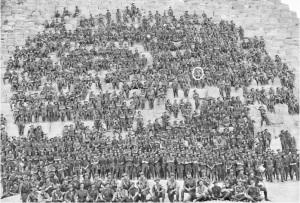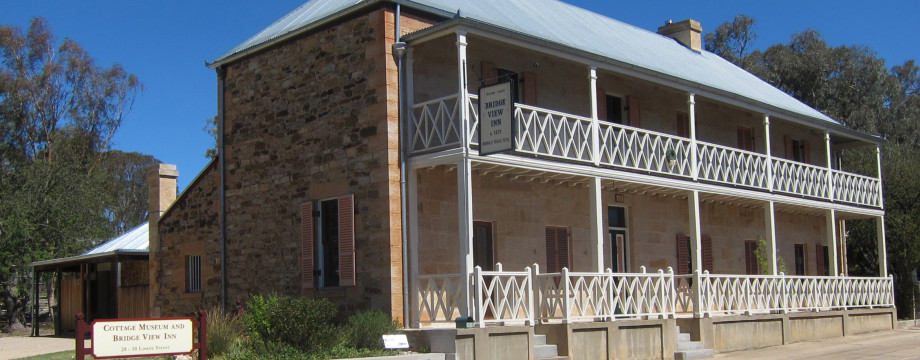The first men to enlist in the Australian Imperial Force (AIF) were sent not to Europe, as they had expected, but to Egypt for further training and to protect British interests in the Middle East and the Suez Canal. Australian soldiers wrote long letters home describing their adventures.
Sapper Ernest Charles Tubbenhauer, a printer who had worked for the Western Post before the war, wrote from the Mena Military Camp, Pyramids Valley, Egypt, on December 14, 1915, where he was with the 1st Division Engineers:
‘We are camped in the Valley of the Pyramids with two of the big Pyramids in sight. They are an enormous size – a wonderful piece of work…All the Australian troops except the Light Horse are camped out here. The Light Horse are camped on the other side of town. The New Zealanders are with them…The camp is like a huge town. It is laid out in streets and blocks and each battalion has a block…We have been making rifle ranges, building latrines, making roads, building mess rooms and a thousand and one jobs which are required in a big camp like this.’
Private James Charles (Charlie) Egan, of Wollar, wrote from Detail Base Camp in February, 1915:
‘It would be a good camp here were it not for the sand. There is not a single thing growing on the desert. It is nothing but a great sandy waste and it seems a pity to see miles and miles of country lying waste. It makes a good training ground, however. Walking through the heavy sand is good exercise and gives us a good appetite.’
“We’re not where we expected to land after all. Gracious me, we having a glorious experience.”
Private George Plows, a 19-year-old railway porter from Dunedoo, had settled into the daily routine:
‘We get up at 6am and have breakfast (or a slice of bread and butter and a cup of tea), and at 7am we go for a six hours’ march across the desert, in sand up to our ankles. We have dinner at 3pm and tea at 6.30, and often have to do a two hours’ march at night. It is winter here now, and the nights are very cold. It is fairly hot in the daytime. It is deadly when you look around and can only see sand for miles.’
After a month in Egypt, Rylstone farmer before the war, Private Kenneth Keech, training as a stretcher bearer with the Army Medical Corps, reported on the Australian soldiers’ progress.
‘There is no doubt about Australian fellows now for soldiers. As Sir Geo. Reid told us the other day, we’re like one big machine now. One time we used to drill like lost men. Training works wonders. The training I’m getting in nursing and first aid will never be awkward knowledge to carry.’
The Australian soldiers were the highest paid of any in the allied forces, something the Egyptian business people were quick to take notice of. Private Tubbenhauer wrote:
‘It was pay day today amongst the troops and the men have been paid right up to date. A big majority of men in our company are drawing their full money and drew from £8 to £14 a man and will spend every penny of it, so you can imagine the difference it makes to this place. However, I understand that the military authorities are only going to pay 2/ [shillings] a day limit while we are in Egypt. That means a lot of the men’s money will be kept in Australia as the men will only be able to draw 14 a week instead of 35/…We are getting a holiday on Xmas day, so after dinner I am going to do a bit of exploring in the native quarters of Cairo. There is a party of ten of us going to Cairo on donkeys. We have our promised leave till 11.15pm so are looking forward to a good time….
There is a lot of Mudgee boys here, Jack Collyer, Harry Collins, Horace Kear and lots of others. With me in the Engineers is a young chap from Gulgong (Alf O’Brien).’

Sergeant Jack Wright, of Buckaroo, in an enlargement from the photograph of the 1st Light Horse, taken at the Pyramids of Cheops.
Cairo traders went to great lengths to attract the Australian soldiers’ piastres, Private Egan reported.
‘All the restaurants and saloons have been renamed in Cairo, such as the Triple Entente Dining Room, the Allies Cafe. But the Australians seem to take precedence also, for everywhere you will see the names such as The Australian Bar, the Kangaroo Cafe, and the New Zealand Bar, and they have special prices for the Australians and the New Zealanders. If you happen to stop to look at anything displayed for sale, the shopkeeper will come out and say ‘Come Inside Australia, for Australia very Good’…If you go out to the Pyramids, the guides crowd around you calling out ‘Australia very good. Me show Australia. Australia plenty money.’ But it amused me to see the Wattle Blossom Bar in Cairo the other night. I have not seen the Waratah yet, but expect that it is stuck up somewhere in Cairo.’
Private Jack Colless, a railway porter from Mudgee, spent a Sunday off duty climbing to the top of the Cheops Pyramid with a mate, Harry Judd.
‘Now, as this place is 450 ft high, it took us a good while to reach the top. Of course, steps 2ft and 2ft 6in apart make the progress fairly easy. However, we reached it somehow. The top is a level of about 20 ft by 20ft, so there is heaps of room to walk about. The most beautiful panoramic view imaginable greeted us on arrival. On one side, we got a splendid view of our camp, which if the people of Australia could only see on paper, would be worth thousands. On another side are the remains of an ancient city, and natives are excavating for hidden treasure, also a number of tombs, which was a wonderful sight.’
Sapper Tubbenhauer, meanwhile, was brushing up on his ancient history:
‘I got away at 10 o’clock on one of our company bicycles and went to Cairo. First of all we visited the Zoo at Getzea (Giza) which is five miles from camp on the Cairo Road…Have read a lot about the ancient Egyptians and it was a treat to go through the Museum and spend the afternoon there, seeing stuff which is thousands of years old. I saw several mummies, including Ramses II, who according to the guide was ‘damn no good’.’
Some of the units had smuggled mascots into the camp, including George Plows’ 4th Battalion, C Company.
‘Some of our chaps had smuggled the little nanny goat we had at Kensington (Sydney) on to one of the horse boats and we have it here now. One of our chaps, when we were out on a long march, picked up a little pup and carried it in his knapsack for three hours. It is the pet of the company.

The 1st Field Company Engineers, possibly including Sapper Ernest Tubbenhauer, pose for a photo with The sphinx and one of the pyramids. Photo courtesy Tubbenhauer family
The 1st Division Engineers were finding ways to vary their diet, Sapper Tubbenhauer reported:
‘We were working today on a suspension bridge over one of the canals about three miles from camp. We also had a demonstration with gun cotton. We put 2oz of it in a tin and sunk it in the water and exploded it with electricity. The explosion killed a lot of fish. Some of them weighed a lb. We had a tip-top feed of fish for tea.’
Having seen the Pyramids, the Zoo and the Museum, by March, Private Keech was looking for new places to visit.
‘When I get leave tomorrow afternoon I will go through some of the following places which I am going to visit but it will take more one day to do the lot: School of Agriculture, Boy’s High School, Girl’s School and an immense brewery. I went through a cigarette factory yesterday, where 1,000,000 cigarettes are made daily from Turkish and Greek leaf.’
After four months in Egypt, the men were eager for action. Private George Plows, after completing a 15-hour march, wrote:
‘All the boys are sick of Egypt. It was all right at first but things are pretty stale here now.’
In April, 1915, the Mudgee Guardian published a short report under the headline: “Australians Gone Forward”.
‘A post card have been received from Mr E. Tubbenhauer, who is with the Australian Expeditionary Force abroad. It shows that the Australians have at last started from Egypt at the front – presumably for the Dardanelles region. The card reads simply; – “Nothing is to be written on this side except the date and signature of the sender. Sentences not required may be erased. If anything else is added the post card will be destroyed.” Ernest Tubbenhauer had written: I have received your letters dated January 14th and 24th. Letters follow at first opportunity. Ernest C. Tubbenhauer, Feb. 7th, 1915.’
Due to the time taken for letters to reach Australia, the letter was published on April 26, 1915, by which time, unbeknownst to Australians at home, Sapper Tubbenhauer and his fellow Anzacs were fighting for their lives on the beaches and cliffs of Gallipoli.

Group portrait of all the original officers and men of the 11th Battalion, 3rd Brigade, AIF, on the side of the Great Pyramid of Khufu (Cheops) near Mena camp. The Australian War Memorial had identified the soldier circled as Sergeant John (Jack) Wright, formerly of Buckaroo, near Mudgee (circled). A large version of this photograph is on display at Club Mudgee. Courtesy of the Australian War Memorial Accession No: P05717.001
Source: Mudgee Guardian, website article, http://www.mudgeeguardian.com.au/story/3020538/the-road-to-gallipoli-the-anzacs-in-egypt/?cs=4131, accessed 2 August 2016.

